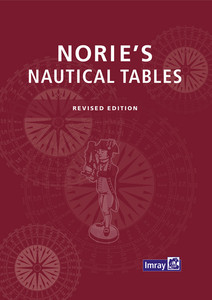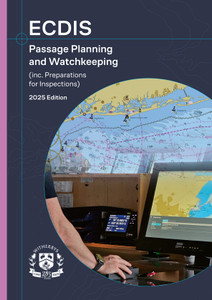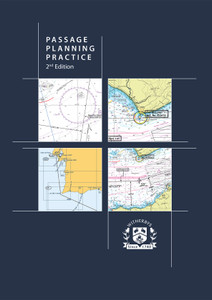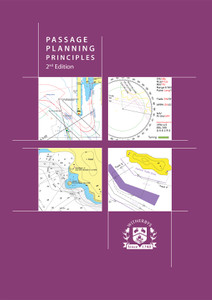
The fully updated edition of 'Passage Planning Guidelines 2025' includes four separate publications presented in a slipcase. These titles discuss the latest procedures, guidance and best practice required for good navigation.
The following titles are included in 'Passage Planning Guidelines 2025':
- 'Passage Planning Guidelines 2025 (inc. Preparations for Inspections)'
- 'Radar and ARPA'
- 'Safe Nav Watch'
- 'Teamwork on the Nav Bridge'
'Passage Planning Guidelines 2025' focuses on the appraisal and preparation stages of voyage planning using traditional methods, paper charts and ECDIS. This edition now includes two new chapters covering execution and monitoring, as well as new guidance on preparation for PSC, audits and inspections.
The Guidelines reflect the industry's shift towards ECDIS and ENCs as the primary means of navigation, while still covering traditional paper chart methods. This edition provides updated imagery, detailed ECDIS passage planning guidance and practical calculation examples. The annexes of the 'Passage Planning Guidelines 2025' provide detailed templates of passage planning checklists, including an ECDIS planning checklist and appraisal report.
'Safe Nav Watch' provides essential guidance on safe navigational watchkeeping, identifying potential hazards and how to avoid them. Drawing on the expertise of experienced mariners, the book reinforces best practices in line with all applicable SOLAS amendments and bridge equipment performance standards.
Advice relating to bridge practices for navigating extreme weather, has been expanded with updated guidance on weather routeing and charts. New sections on helicopter operations, anchoring and watchkeeping at anchor have been added to bridge practices for navigating coastal areas. Chapter 8:'Lessons from Navigation Incidents', features new and current case studies which analyse real-world errors and advise the industry-approved best practices for preventing similar incidents.
'Teamwork on the Nav Bridge' is based on original text from a leading trainer of cockpit resource management. The text has been fully revised and updated to reflect the importance of defending against the consequences of human error. It includes guidance on subjects such as situational awareness, decision-making by the bridge team and the concept of bridge resource management (BRM). It also details the importance of keeping fit for duty, ensuring adequate rest and managing the circumstances that contribute to fatigue on board.
Radar is a vital tool for safe navigation and collision avoidance at sea, providing continuous situational awareness in both clear and restricted visibility. A new 'Radar and ARPA' guide has been added to the 2025 Guidelines. It explores the principles of marine radar operation, the integration of ARPA for target tracking and the essential skills required for effective radar interpretation. Covering key regulations, including Rule 7 of the COLREGs, and the importance of understanding radar capabilities and limitations, this book is an essential resource for navigators seeking to enhance their proficiency in radar use.
A passage plan, or voyage plan, is developed by a Navigation Officer as a way of safely identifying a suitable route a ship can take from one location to another, usually from a berth at one port to a berth at another. Effective passage plans require skill, experience and meticulous research. While one officer is primarily in charge of creating the plan, prior to use, it should be verified by the entire bridge team and approved by the Master. It is a task that is vital for the safety of the ship and carries a weight of responsibility. The consequences of omitting important information and/or failing to safely plan the passage can be serious for the ship and its crew, and therefore it is not something that should be taken lightly.
The Navigation Officer preparing the passage plan (the 'navigator') must be diligent and seek to produce a comprehensive and detailed 'berth to berth' plan based on a full appraisal, taking into account all possibilities and eventualities. The plan should remove all risk, where possible, and where risk may still exist, it should be reduced to the safest minimum possible.
An effective passage plan, whether completed using paper charts, ECDIS or both, must:
- Establish appropriate safety settings or margins for each stage of the voyage, taking into account the requirements of the company's safety management system (SMS)
- clearly define a safe navigational route from berth to berth
- be comprehensive and contain an appropriate level of detail for each leg of the voyage
- reduce navigational risks to as low as reasonably practicable
- be easy to understand and follow by any officer involved in navigation of the ship
- include contingency options and abort points at critical areas
- satisfy environmental protection requirements and highlight any MARPOL or ECA areas which may be of concern
- include details on all radiocommunication requirements
- be checked visually and electronically by the bridge team
- be reviewed and approved by the Master, prior to the execution and monitoring stages.
In November 2021, the UK Supreme Court reaffirmed the decision that a defective passage plan effectively renders the ship legally unseaworthy. In the case under question, a large container ship went aground. The company was held liable for several million dollars when it was determined that the chart had not been properly updated. It was confirmed that the passage plan (appraisal and planning stages) and subsequent navigation outside a buoyed fairway did not reflect a warning given in a Notice to Mariners. The warning stated that the depths shown on the chart outside the fairway were unreliable and that the waters were shallower than those recorded on the chart. Therefore, the importance of a well-made passage plan should not be underestimated.
SOLAR Chapter V requires:
All ships of 300 GT and above to be fitted with a 9 GHz radar. In addition, a 3 GHz radar is required to be fitted on all ships of >3,000 GT, although a second 9 GHz radar may be fitted instead if considered appropriate by the flag State.
Marine radars use a rotating antenna powered by a magnetron or a solid-state power amplifier to transmit a narrow beam of microwaves around the ship and out across the horizon. Targets are detected when the microwaves are reflected back, amplified and converted for display.
Radar is a valuable tool for the safety of navigation and collision avoidance. In conditions of both clear and restricted visibility, it provides:
- A means to continuously monitor the ship's position in coastal areas along the planned track, even when other methods of position fixing, such as GNSS or visual methods, are not available
- the means to locate other traffic and objects around own ship.
There are alternative types of radar that are used for specific purposes, such as wave radars and ice radars.
Radar when combined with an ARPA, also known as 'Target Tracking', is essential for assisting the OOW with information for collision avoidance and navigation. Rule 7 of the COLREGs requires that "proper use shall be made of radar equipment if fitted and operational, including long-range scanning to obtain early warning of risk of collision and radar plotting or equivalent systematic observations of detected objects." However, it is clarified further that "assumptions shall not be made on the basis of scanty information, especially scanty radar information." As such, care must always be taken by the OOW when using the information from the Radar/ARPA to make decisions for alterations of course and/or speed.
The ability of navigators to successfully interpret the displayed picture on a radar depends on their understanding of the characteristics of radar propagation, the capabilities of the radar, the reflecting properties of different radar targets, and the navigator's ability to analyse the situation and compare the displayed picture to it.
This publication provides guidance on safe navigational watchkeeping and highlights potential issues and pitfalls. It is based on advice and guidance from experienced mariners, reinforced by best practice.
Safe navigation is now more important than ever, as:
- Every mistake is a potential human and environmental catastrophe
- Masters and officers can be faced with fines, if incompetence is proved, as well as potential imprisonment
- incidents can result in reputational damage and financial loss for companies
- every mistake is scrutinised by a global media audience and even small errors are now shown in videos online.
Navigation is regarded as an art despite the fact that it is increasingly dominated by technology. Watchkeeping in the digital age presents the same challenges, just in different forms. The availability of technology should never diminish the importance of watchkeeping and maintaining a proper lookout, or monitoring the ship's position along a prepared route. As ships have transitioned to ECDIS as their primary means of navigation, it must be remembered that the four stages of passage planning – appraisal, planning, execution and monitoring (APEM) – are just as critical whether the navigating officer is using an ECDIS or paper charts.
Much of the content of this book is abridged from 'Navigating the Human Element' by Captain Timothy Crowch, a pilot with over 40 years' experience of commercial aviation and 10 years working with the maritime industry. It has been further developed for inclusion in this publication with his permission. As an expert investigator, he participated in a number of high-profile investigations into aviation-related accidents and incidents. His experience and advanced training led him to develop and produce safety awareness training, education and accident prevention programmes for complex industries, including insurance, aviation, maritime and healthcare.
This book highlights the importance of defending against the consequences of human error. It includes guidance on subjects such as situational awareness, decision-making by the bridge team and the concept of bridge resource management (BRM). It also details the importance of keeping fit for duty, ensuring adequate rest and managing the circumstances that contribute to fatigue on board.
Chapter 1 - Introduction
Chapter 2 - Appraisal
Chapter 3 - Passage Planning on Paper Charts
'Radar and ARPA'
Chapter 1 - Principles of Radar
Chapter 2 - Set-up and Use of the Radar
Chapter 3 - Errors and Limitations of the Radar and ARPA
Chapter 4 - PM, Maintenance and Other Considerations
'Teamwork on the Nav Bridge'
Chapter 1 - What do we Mean by 'Human Error'?
Chapter 2 - Defences Against the Consequences of 'Human Error'
Chapter 3 - Bridge Resource Management (BRM)
Chapter 4 - Working with a Pilot on Board
Chapter 5 - Keeping Fit for Duty
Chapter 6 - Fatigue
'Safe Nav Watch'
Chapter 1 - Bridge Equipment (Carriage Requirements)
Chapter 2 - Bridge Equipment (Overview and Usage)
Chapter 3 - Prerequisites for Watchkeepers
Chapter 4 - Bridge Practices - At All Times
Chapter 5 - Bridge Practices - Weather
Chapter 6 - Bridge Practices - Coastal Navigation
Chapter 7 - Emergencies
Chapter 8 - Lessons from Navigation Incidents
Chapter 9 - Bridge Preparedness
Witherbys
Witherbys titles are developed using scripts developed by technical experts that are peer reviewed within work groups. Typically, they seek to improve understanding of the regulations, recommendations and guidelines issued by Industry.
Witherbys staff have significant expertise in the fields of navigation and hazardous cargoes as well as in the presentation of complex subjects in a graphic and easy to understand manner.
- Number of Pages:
- 626
- Published Date:
- April 2025
- Book Height:
- 300 mm
- Book Width:
- 210 mm
- Weight:
- 2.3 kg
- Publication Date:
- April 2025
- Author:
Witherbys
- ISBN:
- 1917308425
- Preview:
- Yes






